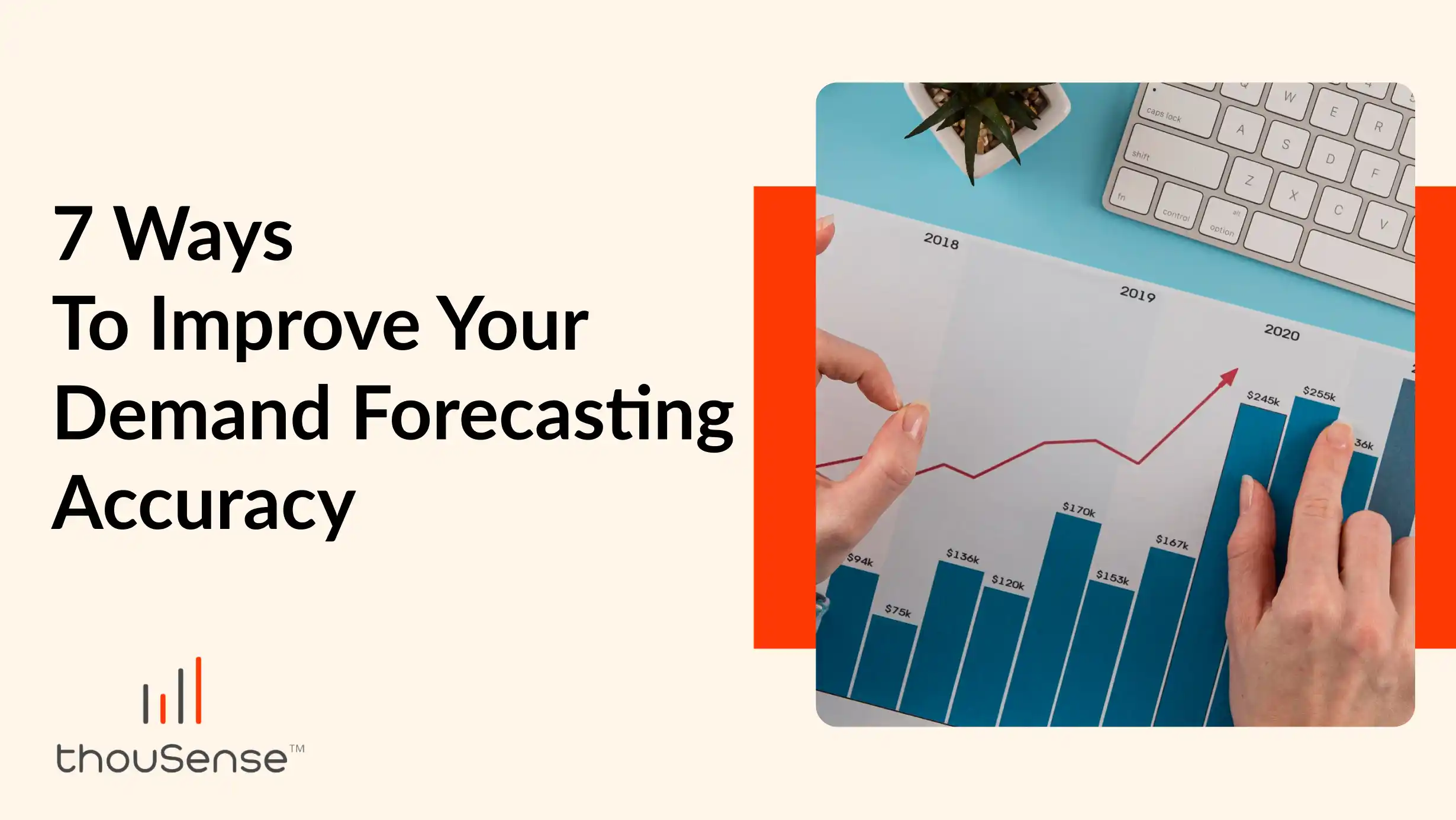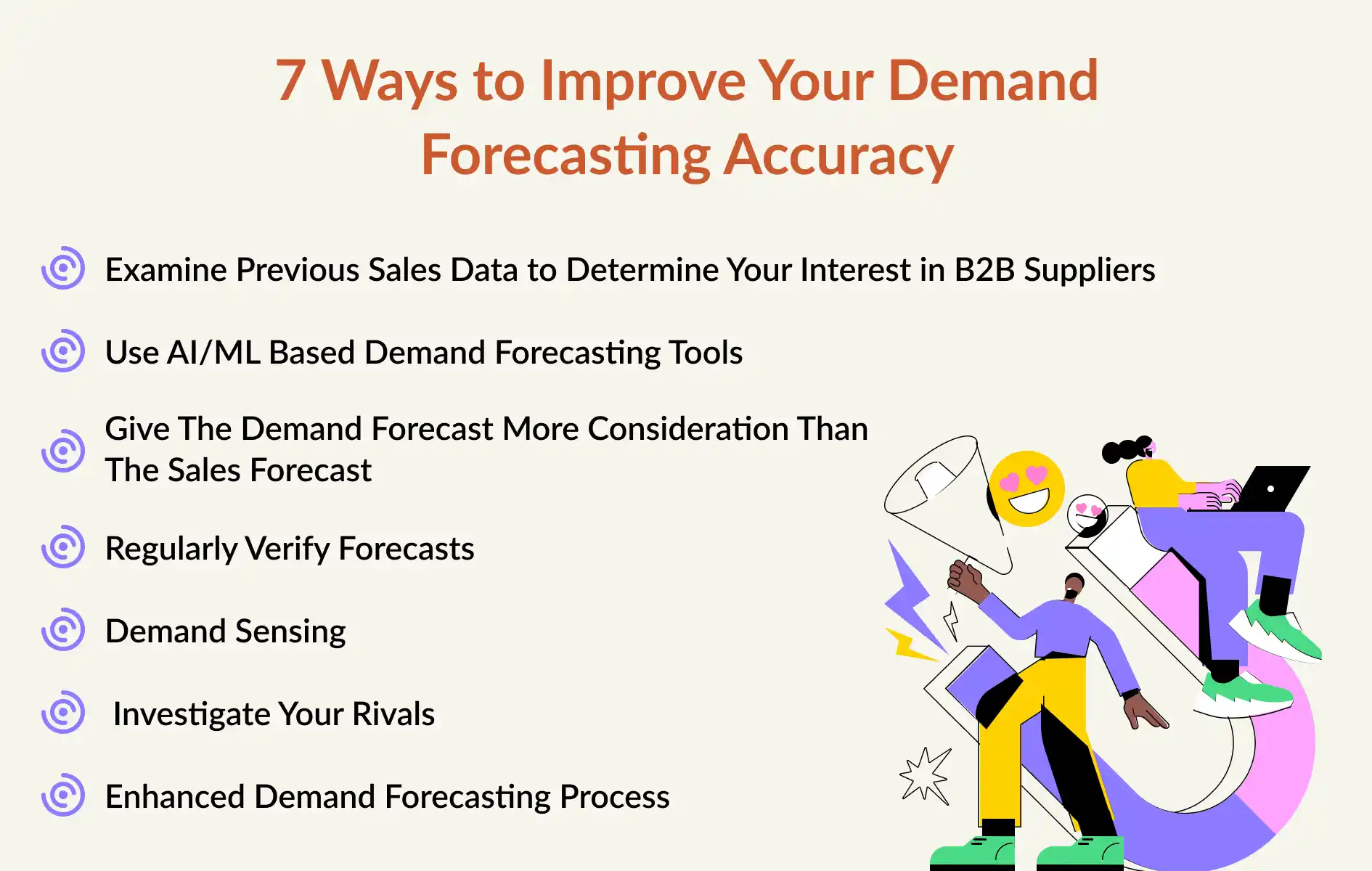7 Ways To Improve Your Demand Forecasting Accuracy| thouSense

Demand forecasting is a vital and practical tool used by many businesses. However, the majority of firms also state that they are dissatisfied with the lack of accuracy in their planning process and are looking for improvements.
While waiting for backorders, customers may hunt for a comparable product from a different retailer for a variety of reasons. Sales would suffer as a result. Because the consumer is dissatisfied, the proprietors suffer in any case.
To put it simply, to turn a profit and satisfy customers, supply and demand must be satisfied. The forecasting approach can solve this equation. Demand forecasting is the process of estimating future needs using data from both the past and the present. Ensuring you have the appropriate amount of goods on hand for the upcoming several months can be achieved by using forecasts. Numerous technologies for demand forecasting and supply chain planning are available to forecast what consumers will wish to purchase in the upcoming days, weeks, or months. However, there'll always be some degree of ambiguity in the forecast.
Why Is Demand Forecasting so Important?
Demand forecasting is growing increasingly widespread across industries, therefore it's critical to understand why businesses are selecting it. Due to its numerous benefits, demand forecasting is crucial for businesses. A case study claims that it increased a company's sell-through rate by 18%, reduced inventory by 7%, and increased recurring business by 13%.
● Benefits for Budgeting:
Budgeting is challenging in the absence of demand projections. In what other way could you budget for future purchases?
Let's say you underestimated the amount of product you would require due to a lack of demand knowledge. Purchasing more things comes at a lower cost.
This means that inventory can make it difficult to generate the cash flow needed to launch a new advertising campaign or invest in a new product line.
● Establishing a Price Plan:
You may be able to determine the appropriate price for your good or service by considering the on-demand strategy. This might be a great idea, but you must be fairly knowledgeable about both your industry and your rivals.
For example, you may swiftly sell off what you already have by lowering the price if you have sufficient stock and you know that a younger model is on the way. This would allow space for the upcoming models. In situations where there is a high demand and a limited supply, you might also utilize the concept of rarity to increase a product's price.
● Reduction of Backorders:
Although unanticipated spikes in demand are always possible, effective demand forecasting can help minimize backorders (e.g., when a product that was previously in low demand becomes famous, is advertised on television, or is supported by a strong person).
When you don't have enough stock to meet demand, you get backorders. Customers might get mad at them and choose to go to a competing business instead. You might lose them for good if they end up being like the rival. By planning and meeting customer needs, you can lower the chance of losing popular items when you run out.
● Keeping Stock:
Predicting demand requires keeping track of the products. Keeping extra inventory on hand will help ensure that you always have enough to meet consumer demands and prevent you from running out of things.
To maintain track of their inventory and ensure that they always have the proper quantity of products on hand, businesses should set up an inventory management system. A company may track sales orders, determine how much stock they have, and predict future demand with the aid of an inventory management system.
Additionally, having an adequate supply of products on hand helps businesses maintain pleased customers and prevent a decline in sales.
● Restocking at a Lower Cost:
There are numerous economical methods for refilling. Remembering that replenishing is a continuous process that requires preparation and time is the most crucial thing to remember. Refills can be purchased in bulk and saved for a significant discount.
Larger purchases typically result in greater discounts and savings, which over time can add up to significant savings. Additionally, it's critical to shop about and compare pricing at several vendors and businesses to ensure you're receiving the greatest bargain.
Finally, but just as importantly, keep a watch out for manufacturer and merchant sales and exclusive offers. They might provide even greater savings.
7 Ways to Improve the Accuracy of Demand Forecasting
From this vantage point, it is reasonable that merchants would wish to enhance their capacity for accurate demand estimation. A few areas are particularly noteworthy for being excellent locations to add value fast. The following seven practical methods can be applied to raise the overall effectiveness of supply chain management, the precision of demand forecasting, and the accuracy of restocking:

1. Examine Previous Sales Data to Determine Your Interest in B2B Suppliers
Because of supply chain inventory buffers, point-of-sale (POS) data isn't always reliable for manufacturers that are farther from the point of sale or the final consumer. At the very end of the supply chain, POS data can help strengthen the demand signal. By using historical data, such as sales records, open order histories, and current open orders, downstream manufacturers can increase the accuracy of demand forecasting.
2. Use AI/ML Based Demand Forecasting Tools
Different kinds of artificial intelligence tools perform very well in a data-rich supply chain environment. These tools are made up of using AI/ML models.
Retailers may continuously learn from new data by utilizing AI-based forecasting tools, which improves demand planning and forecasting models over time.
The most advantageous feature of AI-based forecasting tools is their ability to adjust to shifting market conditions, shifting consumer preferences, and a host of other variables, hence the use of AI significantly enhances the accuracy of demand forecasting compared to traditional methods.
3. Give The Demand Forecast More Consideration Than The Sales Forecast
Supply and demand matching is the most crucial aspect of forecasting. However, if you want to improve your predictions, you need to consider them as two distinct entities.
When a company runs out of a particular line of products, it indicates that no sales were made during that time. Demand is still high, but it cannot be satisfied until the product is delivered. On the demand side, things are as they are.
However, historical evidence indicates that there were no sales since there was no demand. As a result, demand data is crucial since the distinctions between these two kinds of information may be crucial in forecasting.
4. Regularly Verify Forecasts
As soon as data is available, estimates based on both quantitative and qualitative data should be compared with actual sales. Make sure your future projections are grounded in the state of the market and utilize any adjustments you make to improve them.
You should examine your competitors' performance in the market and with their sales as part of these truth checks. When you join a new market, you should consider how the entry of competitors into the market and its subsequent growth can affect your market share.
These reality checks must be performed frequently. You ought to perform them more frequently if the product is fresh or the market is evolving swiftly. Keep a tight eye on sales and feedback, and adjust your projection as needed.
5. Demand Sensing
When retailers collect real-time demand signals and market data using AI-based forecasting tools like thouSense, their forecasts are significantly more accurate. Retailers may be better equipped to make decisions and react to shifts in demand more quickly if they monitor consumer behavior, industry performance, economic indicators, and other data sources specific to their line.
6. Investigate Your Rivals
Collaborate with the appropriate individuals in your organization to comprehend market trends and your competitive advantage. This is particularly crucial when introducing novel product categories that draw in new clients.
Based on the information provided by your competitors, you can infer a great deal about your own business. Make an effort to comprehend the potential for earning money. After that, you can adjust your goals by examining the seasonal variations they observe. To do this, familiarise yourself with their product lineup and the release schedule for new items.
7. Enhanced Demand Forecasting Process
Stores have discovered in the last several years how crucial it is to prepare for any scenario in the modern supply chain. This means that in order to enhance supply chain operations and make better decisions, retailers should employ AI-based demand forecasting tools. These AI-powered forecasting tools can determine the most efficient ways to schedule manufacturing, transport products, maintain inventory, and take other actions that lower costs, enhance quality, and optimize the supply chain as a whole.
Why Should You Select thouSense?
Accurate forecasting is essential for supply chain management as well as the overall sales and operations plan of the business. The accuracy of demand forecasts can be increased by utilizing a variety of models and data sources. Everyone in a business will benefit more from knowledge the quicker it is obtained and disseminated.
Using demand forecasting tools powered by thouSense is one approach to make this work. These AI-based forecasting programs can be used by demand and buying teams to generate predictions, collaborate, model, and combine data, and report in order to maximize the value of critical knowledge and information.
Conclusion
A study of demand forecasting shows that being able to predict how sudden changes in demand will impact a business's operations and finances is a useful skill. If a business knows how unplanned interruptions could affect its processes and finances, it can better plan for them.
Predicting what will happen when there is a sudden change in demand can also help businesses understand what might happen when outside factors affect their processes. Companies can use this knowledge to come up with plans that will help them stay competitive and quickly adapt to changes in what customers want.
FAQs
1: How Accurate Is Demand Forecasting?
Answer: While not 100% accurate due to unforeseen factors, AI-enhanced demand forecasting significantly improves prediction reliability.
2: Can Demand Forecasting Reduce Inventory Costs?
Answer: Yes, by aligning stock levels with predicted demand, thereby minimizing excess inventory and associated costs.
3: Can Small Businesses Benefit from Demand Forecasting?
Answer: Absolutely, demand forecasting helps small businesses optimize inventory and meet customer demand efficiently.